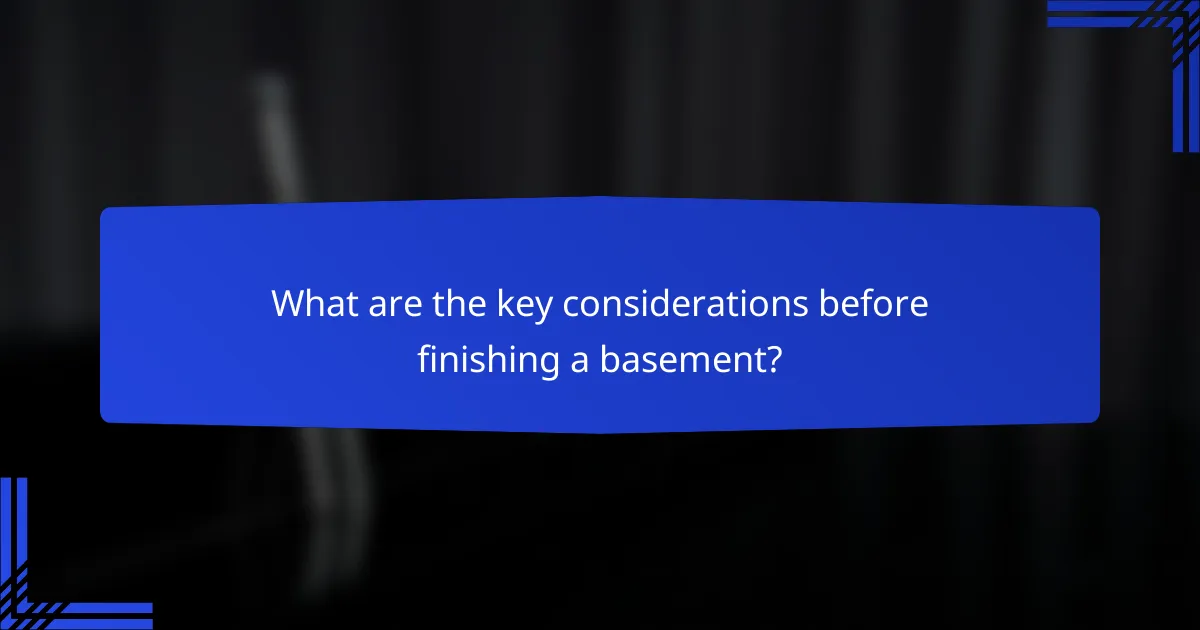Finishing a basement is an excellent way to create additional living space while increasing your home’s value. This transformation allows homeowners to design versatile areas tailored to their needs, enhancing both functionality and aesthetics. With various design options available, the possibilities for customization are virtually limitless.

How can basement finishing increase home value in the UK?
Finishing a basement can significantly boost a home’s value in the UK by transforming unused space into functional living areas. This enhancement not only adds square footage but also appeals to buyers looking for versatile homes.
Higher resale value
Investing in basement finishing can lead to a higher resale value, often recouping a substantial portion of the renovation costs. Homeowners can expect to see an increase in their property’s worth, sometimes ranging from 10% to 20%, depending on the quality of the finish and local market conditions.
When evaluating the potential return on investment, consider the overall condition of the home and the quality of materials used in the basement renovation. High-quality finishes and well-planned layouts tend to attract higher offers from buyers.
Attracts potential buyers
A finished basement can attract a wider pool of potential buyers, particularly families seeking extra living space. Many buyers in the UK prioritize homes with additional rooms for play areas, guest suites, or home offices, making a finished basement a desirable feature.
In urban areas where space is limited, a well-designed basement can be a key selling point, providing a competitive edge over similar properties without such enhancements.
Improved marketability
Finishing a basement improves a home’s marketability by showcasing its full potential. A well-finished basement can be marketed as a multi-functional space, appealing to various buyer needs, from entertainment areas to home gyms.
To maximize marketability, ensure the basement is well-lit, properly ventilated, and meets local building regulations. Highlighting these features in listings can attract more interest and lead to quicker sales.

What are the design options for basement finishing?
Basement finishing offers various design options that can enhance functionality and aesthetics. Key considerations include the intended use of the space, layout preferences, and personal style, allowing homeowners to create a customized environment that meets their needs.
Open-concept layouts
Open-concept layouts in basement finishing promote a spacious feel by eliminating walls between different areas. This design is ideal for socializing, as it allows for easy flow between spaces such as a living area and a kitchenette. Consider incorporating large windows or sliding doors to enhance natural light and create a more inviting atmosphere.
When planning an open-concept basement, ensure that you account for structural support and local building codes. It may be necessary to consult with a contractor to determine which walls can be removed without compromising the integrity of the home.
Home office spaces
Transforming a basement into a home office can provide a quiet, dedicated workspace away from household distractions. Consider factors such as adequate lighting, soundproofing, and ergonomic furniture to create an efficient environment. A well-designed home office can significantly improve productivity and work-life balance.
Incorporate storage solutions like built-in shelves or cabinets to keep the space organized. Ensure that your office has sufficient electrical outlets for devices and consider the placement of your desk to take advantage of any natural light available.
Entertainment areas
Entertainment areas in a finished basement can serve as a family room, game room, or home theater. These spaces can be designed with comfortable seating, a large screen for movies, and gaming consoles to cater to various entertainment needs. Adding features like a wet bar or mini-fridge can enhance the experience for guests.
When designing an entertainment area, consider soundproofing options to minimize noise disturbance to the rest of the house. Additionally, ensure that the layout allows for easy movement and interaction among guests, creating an inviting atmosphere for gatherings and events.

What are the costs associated with basement finishing?
The costs associated with basement finishing can vary widely based on several factors, including the size of the space, the quality of materials, and the complexity of the design. Generally, homeowners can expect to invest a significant amount to transform an unfinished basement into a functional living area.
Average cost per square foot
The average cost for basement finishing typically ranges from $50 to $150 per square foot, depending on the level of finish and local labor rates. For a standard 1,000 square foot basement, this could translate to a total investment of $50,000 to $150,000.
Higher-end finishes, such as custom cabinetry or high-quality flooring, can push costs even higher. It’s essential to get multiple quotes from contractors to understand the pricing landscape in your area.
Factors affecting pricing
Additionally, local market conditions and the availability of materials can impact pricing. It’s advisable to budget for unexpected expenses, as renovations often uncover issues that need addressing.
Potential return on investment

What are the key considerations before finishing a basement?
Before finishing a basement, consider building regulations, moisture control, and electrical and plumbing needs. These factors ensure the space is safe, functional, and compliant with local codes.
Building regulations in the UK
In the UK, finishing a basement requires adherence to local building regulations, which include planning permission and compliance with safety standards. It’s essential to check if your project needs approval from your local council, especially if you plan to alter the structure significantly.
Key regulations often involve fire safety, ventilation, and egress requirements. For example, you may need to install fire-resistant materials and ensure adequate escape routes in case of emergencies.
Moisture and insulation needs
Moisture control is critical when finishing a basement, as dampness can lead to mold and structural damage. Use a vapor barrier on walls and floors to prevent moisture intrusion, and consider dehumidifiers to maintain optimal humidity levels.
Insulation is equally important to keep the space comfortable. Aim for insulation that meets or exceeds local energy efficiency standards, typically around 50-70 mm of rigid foam or similar materials, to ensure warmth and energy savings.
Electrical and plumbing requirements
When finishing a basement, electrical and plumbing systems must be installed according to local codes. This often involves hiring licensed professionals to ensure safety and compliance, especially for wiring and plumbing connections.
Plan your layout carefully, considering the placement of outlets, lighting, and plumbing fixtures. It’s advisable to incorporate multiple outlets and adequate lighting to enhance usability, while also ensuring that plumbing systems are properly vented and insulated to prevent freezing in colder months.

How does basement finishing improve living space functionality?
Basement finishing enhances living space functionality by transforming an underutilized area into a practical and versatile environment. This process not only increases usable square footage but also allows homeowners to customize the space to meet their specific needs.
Additional bedrooms
Finishing a basement can create additional bedrooms, which is particularly valuable for growing families or those looking to accommodate guests. These bedrooms can be designed to meet local building codes, ensuring safety and comfort.
When planning for additional bedrooms, consider factors such as egress windows for safety, soundproofing for privacy, and adequate lighting to create a welcoming atmosphere. This can significantly increase the home’s appeal and market value.
In-home gym options
Transforming a basement into an in-home gym is an excellent way to enhance functionality while promoting a healthy lifestyle. This space can accommodate various equipment, from weights to cardio machines, allowing for a convenient workout environment.
When designing an in-home gym, ensure proper ventilation and flooring that can withstand heavy use. Consider adding mirrors and adequate lighting to create an inviting workout space that motivates regular exercise.
Flexible family spaces
Finishing a basement can provide flexible family spaces that serve multiple purposes, such as a playroom, media room, or home office. These versatile areas can adapt to changing family needs over time, making them invaluable.
To maximize the functionality of these spaces, incorporate modular furniture that can be easily rearranged and consider soundproofing for activities that may disrupt other areas of the home. This adaptability can significantly enhance the overall living experience.

What are the popular styles for finished basements?
Popular styles for finished basements include modern minimalist, rustic charm, and traditional designs. Each style offers unique aesthetics and functionality, allowing homeowners to choose based on personal taste and how they plan to use the space.
Modern minimalist
The modern minimalist style emphasizes simplicity and functionality, often featuring clean lines and a neutral color palette. This approach typically uses open spaces with minimal decor, creating a calm and uncluttered environment.
When designing a modern minimalist basement, consider using built-in furniture and multi-functional pieces to maximize space. Materials like concrete, glass, and metal are commonly used to enhance the sleek look.
Rustic charm
Rustic charm focuses on warmth and coziness, often incorporating natural materials like wood and stone. This style creates an inviting atmosphere, perfect for family gatherings or relaxing evenings.
To achieve a rustic look, consider exposed wooden beams, reclaimed wood furniture, and warm color tones. Adding elements like a stone fireplace or vintage decor can further enhance the charm of the space.
Traditional designs
Traditional designs in basements often reflect classic styles with rich colors, ornate details, and elegant furnishings. This style tends to create a timeless appeal, making the space feel sophisticated and welcoming.
Incorporate features like crown molding, wainscoting, and classic furniture pieces to achieve a traditional look. Using warm, inviting colors and layered lighting can also help create a comfortable atmosphere in the basement.
